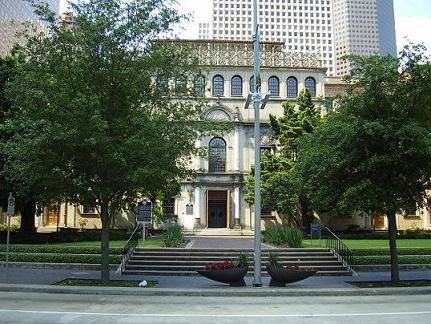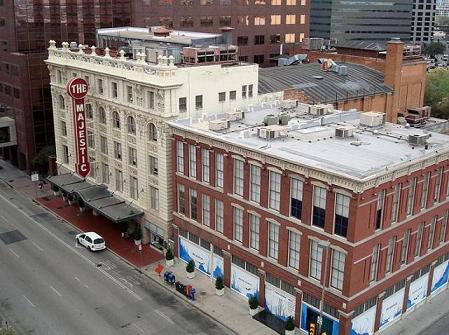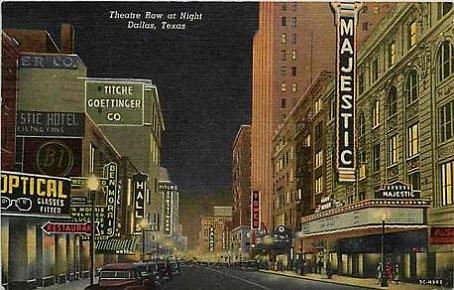The Julia Ideson building, located at 550 McKinney Street in downtown Houston, Texas, was completed as the main public library for Houston, in 1926. It opened to the public on October 18 of that year and was originally called simply the Central Library. The beautiful Spanish Renaissance Revival structure replaced the Italian Renaissance style Carnegie Library building at the corner of Travis Street and McKinney Avenue (currently McKinney Place Garage) that had been completed in 1904 but which fifteen years later was deemed too small for the main library. Designed by architect Ralph Adams Cram of Cram and Ferguson, Boston, the Ideson was added to the National Register of Historic Places in 1977 and since 1979, following extensive restoration, has been home to the Houston Metropolitan Research Center which houses the Texas and local history collection, archives and manuscripts, and special collections of the Houston Public Library. A six-story gray granite structure was constructed on the block across the plaza to the west of the Ideson as the new central library building. Completed in 1976, the latter structure, located at 500 McKinney Street, has been known as the Jesse Jones Building since 1989.
In 1903, Julia Bedford Ideson (1880-1945) was appointed librarian of the Houston Lyceum and Carnegie Library, which position she held for the next forty-one years. One of her many achievements in building collections and facilities of the library system during her service was the addition of the building that years following her death would be renamed in her honor. In 2004, then mayor Bill White initiated a move to update and restore the Ideson, which for years had been used to house the city's archives although cramped for space and deficient in facilities for the proper long-term preservation of paper materials. In 2006, preservation activist Phoebe Tudor founded the Julia Ideson Library Partners, Inc., a public-private partnership with the city, which raised $32-million to expand and preserve the Ideson. An archival wing based on Cram's original plan was added for the Houston Metropolitan Research Center and extensive renovations throughout were made to the rest of the structure. The building was re-opened to the public on December 5, 2011, and much of its current public use is as a venue for meetings, banquets, and weddings.
Although renamed in honor of its long-serving pioneer librarian and administrator, the Ideson Building has the name of another veteran staffer associated with it as well (moreso nowadays in autumn than in other seasons). An original employee in the Ideson was Jacob Frank Cramer. Frank, as many public records show him, was employed as a custodian, beginning about 1913, at the Carnegie Library building and at the Ideson from its opening until his death therein on November 22, 1936. During the time of his employment at the Houston Public Library, he resided in the buildings he maintained. According to some patrons and library professionals, the spirit of Frank Cramer has never left the Ideson.
Born on March 6, 1857, in Baltimore, Maryland, Jacob Frank Cramer was one of five sons of Jacob and Elizabeth "Lizzie" Cramer (Charles, John, Jacob, Adam, and George E., all born in Maryland except for John who was born in Pennsylvania). Frank's parents were German emigrants (Jacob, born in April of 1824 in Baden-Baden; Elizabeth, June 16, 1827, in Hesse-Darmstadt). The family (whose surname was often spelled with a "K") resided in Harford County, Maryland, as shown by the 1850 and 1860 censuses. The 1870 and 1880 censuses list the elder Cramers as residents of Baltimore. Frank Cramer's parents are buried in Salem Cemetery, Jarrettsville, Harford County, Maryland. (The senior Jacob died in June of 1898; Elizabeth, 26 March 1902).
Frank was not enumerated with the family on the 1880 census, so by then he had left home. The next census to show him is the 1895 Iowa state census which lists him in Atlantic, Cass County. By then he was married and the father of four children. He and his family next appear on the federal census of 1900, which lists him in Horton, Brown County, Kansas, as a railroad laborer, the head of a household, consisting of his wife Ida and five children: Lawrence Reynolds, Cecil (a daughter), Lelia, Russell, and Lydia Wilma) . All of the children were born in Ohio except for two-year-old Lydia who was born in Iowa. Ida was Ida M. Reynolds, daughter of Thomas and Lydia Reynolds, whose household was in 1870 listed in Franklin, Marshall County, West Virginia, and in 1880 in Salem, Monroe County, Ohio. (Frank and Ida's son Lawrence, according to his World War 1 draft registration record, was born on April 27, 1883, so an estimated date of marriage for his parents would be early- to mid-1882. Lawrence's World War II draft registration card lists Clarington, Ohio, as his birthplace. Another birth record shows Lelia, sister of Lawrence, born 4 December 1889 in Clarington, as well.) The family was again listed in Brown County, Kansas, on the state censuses of 1905 and 1915, as well as on the 1910 federal census, whereon Frank's occupation was listed as odd jobs. One of Frank's jobs while living in Horton was in the rural free delivery system, having been appointed in 1903 and 1905.
The Houston, Texas, City Directory for 1911 gives the earliest record of Frank's working and living in Houston. Therein he is listed as "Cramer J. F. buttermkr Texas Star Creamery, r[oo]ms 1805 Congress av." City directories for 1913, 1915, 1917, and 1918, indicate that he worked and roomed in the Carnegie library, at 915 Travis. (The 1913 directory shows "Cramer J. F. janitor Carnegie library, r. same," and the 1918: "Cramer J F janitor Carnegie Library res 915 Travis.") The city directory for 1920 indicates a change in employment, listing him as J. Frank Cramer and noting his residence at 114-1/2 Milam but no occupation or place of employment. The 1920 census seems to indicate he was living in a rooming house on Milam Street (probably the one mentioned in the directory) and working as a laborer at a creamery. Interesting is the notation of single as his marital status.
Frank was listed twice on the 1920 census. Besides the Houston, Harris County, Texas, enumeration, he is listed with his wife Ida and their daughter Lelia in Akron, Summit County, Ohio, and working as a laborer in a rubber company. (By this time Akron had become "The Rubber Capital of the World.") Surprisingly, and consistent with the earlier mentioned marital notation, one finds that on 2 July 1927, in Summit County, Ida M. (Reynolds) Cramer married John Godfrey Schwab. The marriage license maintains "that she was once previously married and is now a widow...ed woman [the word divorced, except for the "-ed," is struck out] her married name being Ida M. Cramer." (Interestingly, the marital status shown for J. F. Cramer on the 1930 census is "widowed.")
The same year the new Central Library (the Ideson) opened in Houston, the Houston City Directory listed J. F. Cramer as "janitor Ho[uston] Public Library." Additional directory listings (for the years 1932 and 1935) show J. F. Cramer as the library janitor, and the 1930 census notes his residence there at the (then) 500 (now 550) McKinney Street, as well. There at 500 McKinney on November 22, 1936, J. Frank Cramer (born in Baltimore, Maryland, March 6, 1857, son of Jacob Cramer of Baltimore) died. The informant for the biographical background listed therein was Mrs. John Widman of Bakers, Kansas. Frank's remains were sent to Hiawatha, Kansas, county seat of Brown County. He is interred in Brown County, in Powhattan Cemetery.
Among stories told about the Ideson is that Frank Cramer haunts the building, that he and his German Shepherd dog Petey can be heard there, Frank playing waltzes on his violin and Petey through the gentle clicking of his toenails upon the floor. It has been further maintained that sheets of music have been found in various places throughout the library, inexplicably scattered upon the floor during the night. Other witnesses have reported mysterious ghostly orbs moving inside and outside the building. Some surmise that they are signs of Frank Cramer's spirit moving about in watching over the library.
(Photo credit: Wikipedia)







